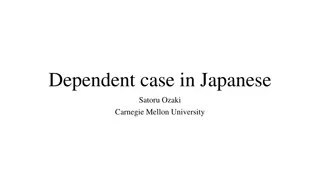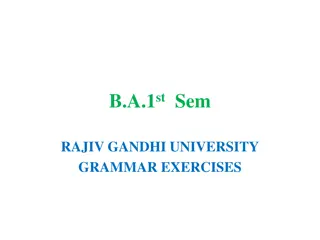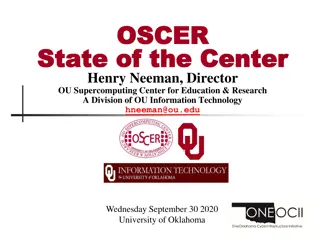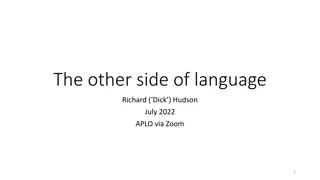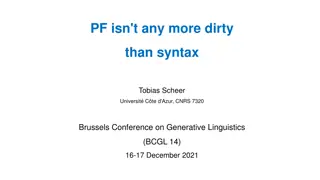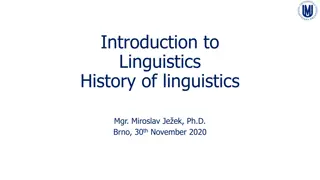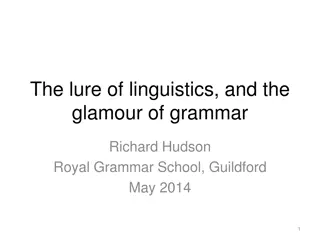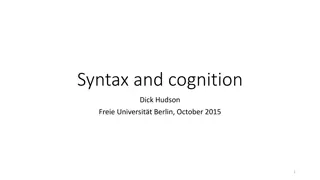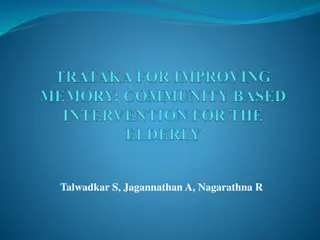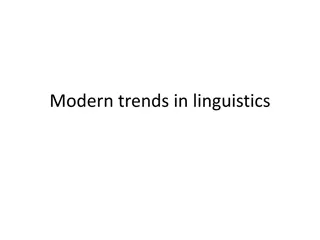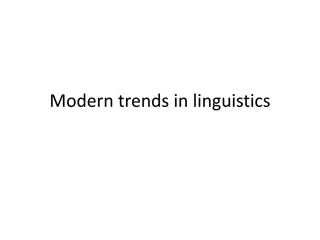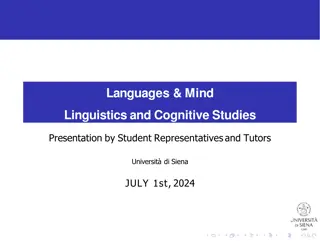Exploring Construction Grammar in Cognitive Linguistics Symposium
Delve into the realm of Construction Grammar with Martin Hilpert in the 35th year of Cognitive Linguistics. Discover the intricacies of idiomatic constructions, the distinction between constructions and constructs, coercion in neologisms, and more. Explore the relationship between Construction Grammar and Generative Grammar, historical linguistics, and the role of corpora in analyzing constructions and constructs.
Download Presentation

Please find below an Image/Link to download the presentation.
The content on the website is provided AS IS for your information and personal use only. It may not be sold, licensed, or shared on other websites without obtaining consent from the author. Download presentation by click this link. If you encounter any issues during the download, it is possible that the publisher has removed the file from their server.
E N D
Presentation Transcript
35 years of Cognitive Linguistics Session 9: Construction Grammar Martin Hilpert
Some constructions are very abstract, some are very specific. Can we call all of these constructions IDIOMATIC? If not, where does idiomaticity start and where does it end?
Where do we draw the line between constructions and constructs? Do some constructs change into constructions?
Is coercion involved in the formation of neologisms? Example: sauce (n.) -> sauced (v.)
Could Construction Grammar explain why it is easier to acquire a language than to learn it?
How does the dictionary and grammar model defend its position against the arguments of construction grammar?
Are Construction Grammar and Generative Grammar really that different?
Are there Construction Grammar approaches to historical linguistics?
How are corpora used in the detection and identification of constructions?
What do speakers know when they know a language?
What speakers have to know: must know words dog, submarine, probably, you, should, etc. what they mean, how they sound must know that there are different kinds of words red is an adjective, tasty is an adjective as well, lobster is a noun, etc. must know how to put words together red can be combined with ball many cannot be combined with milk John saw Mary is ok, John Mary saw is not, but It s John Mary saw is ok must be able to put the right endings on words John walk-s, two dog-s must be able to understand newly coined words festive-ness, under-whelm must know that sometimes more is meant than is said General Motors were able to increase production in the second quarter. I don t know if that is a good idea. must know idiomatic expressions I'm all ears, let s take a break, we really hit it off,
The totality of our knowledge of language is captured by a network of constructions: a construct-i-con. Goldberg 2003: 219 [ ] the network of constructions captures our grammatical knowledge of language in toto, i.e. it s constructions all the way down. Goldberg 2006: 18
Constructions words: cat, philosophy, sparkling, run, ... collocations: I don t know, you bet, see you, ... semi-fixed phrases: keep V-ing, could you please VP syntactic patterns: SUBJ BE V-ed, SUBJ V OBJ1 OBJ2 abstract phrase structures: PREP DET NOUN Speakers knowledge of language = an associative network that connects all of these constructions
Goldberg 1995 sentence patterns that involve a verb and several nominal structures idea: these patterns have meaning their meanings reflect basic recurrent types of everyday experience
argument structure also called valency yawn send
Valency defined The set of participants is called the verb s valency. devour has a valency of two (transitive) hand has a valency of three (ditransitive) exist has a valency of one (intransitive) The participants are called the arguments of the verb.
Traditional idea of valency It s in the lexicon! Each verb is listed in the mental lexicon. In the entry it is specifies with what syntactic contexts the verb can occur. SWEEP intransitive transitive transitive plus resultant state adjective transitive plus path
problems with lexically specified valency speakers use verbs creatively , in syntactic contexts in which they have not heard a verb before: John played the piano to pieces. He pulled himself free, one leg at a time. No matter how carefully you lick a spoon clean, some goo will cling to it. Are there entries such as the following? play: acting on an object in a violent manner that triggers a change of state in that object
alternative explanation The syntactic context dictates a certain interpretation of the verb. coercion: If a lexical item is semantically incompatible with its morphosyntactic context, the meaning of the lexical item conforms to the meaning of the structure in which it is embedded. John plays the piano. John plays the piano to pieces.
coercion at work intransitive verbs: run, sneeze, worry resultative uses: John ran his feet sore. Fred sneezed his cat soaking wet. Bob s mother worried herself sick.
the ditransitive construction SUBJ V OBJ1 OBJ2
the ditransitive construction central sense of the construction: transfer of an object between a volitional agent and a willing recipient: John gave Mary a book several other senses John denied Mary a cookie (blocked transfer) John bequeathed Mary a gold watch (future transfer) several metaphorical meaning extensions: John gave Mary a kiss. John gave Mary an idea.
Why call this a construction? C is a CONSTRUCTION iffdefC is a form-meaning pair <Fi, Si> such that some aspect of Fior some aspect of Siis not strictly predictable from C s component parts or from other previously established constructions. (Goldberg 1995: 4) John baked Mary a cake. Not predictable from the individual word meanings?
implausible verb senses John baked Mary a cake. bake: intend to cause someone else to receive the product of applying hot air to an edible substance John sneezed the napkin off the table. sneeze: move something by means of exhaling in a burst from the nose John talked himself blue in the face. talk: cause someone to become X by means of uttering words
positing constructional meaning instead of ad-hoc verb senses DITRANSITIVE CX: MEANING = TRANSFER BAKE: MEANING = APPLY HOT AIR SUBJ V John baked OBJ1 OBJ2 Mary a cake
Semantics of the ditransitive a volitional agent the agent needs to carry out the transfer willingly John kicked Mary the soccer ball. John threw the squirrels some peanuts. John painted Mary a picture. troublesome data John gave me the flu. The medicine brought me relief.
explanation: CAUSES ARE TRANSFERS Situations of cause and effect are understood metaphorically as situations in which the cause brings the effect to a recipient: The report furnished them with all the information they needed. The new legislation brought new controversies. The accident presented us with a large number of injured workers. Nothing good ever came from smoking.
Semantics of the ditransitive a willing recipient the recipient needs to accept the transfer willingly John kicked Mary the soccer ball. John threw the squirrels some peanuts. * John burned Mary some rice. * John threw the unconscious patient a blanket. troublesome data John gave me the flu. The tabasco sauce gave the dish a spicy flavor. Again, explanation is the CAUSES ARE TRANSFERS metaphor
further metaphorical extensions the conduit metaphor (COMMUNICATION IS TRANSFER OF INFORMATION) John told Mary a joke. John gave Mary his thoughts on the subject. DIRECTED ACTIONS ARE TRANSFERRED OBJECTS John gave Mary a wink. Mary gave John a kick.
further metaphorical extensions FACTS ARE GIVEN OBJECTS I ll give you that assumption I ll grant you that much of your argument BENEFICIAL ACTIONS ARE TRANSFERRED OBJECTS John offered Mary a ride to the airport John owes me many favors
Constructions = meaningful symbolic units
meaningful units Clear for words and idioms spill the beans Some analysis reveals non-compositional meanings of argument structure constructions. SUBJ VERB OBJ1 OBJ2 But very general syntactic patterns such as the plan for a noun phrase? DET ADJ NOUN
meaningful constructions? John sings. Bob heard a noise. One sock lay on the sofa, the other one under it. *One sock lay on the sofa, the other one under.
Do all constructions carry meaning? No, there are semantically empty constructions! All constructions carry meaning.
meaningless constructions 1. formal generalizations with fully compositional meanings SUBJECT-PREDICATE CX (John sings) MODIFIER-HEAD CX (red ball, completely full)
meaningless constructions 2. formal generalizations associated with a heterogeneous set of meanings SUBJECT-AUX INVERSION Will you come to the party? Had I known this, I would have stayed at home. Am I ever hungry! FILLER-GAP CXNS What kind of sandwich did you eat? How many sandwiches he ate! I couldn t count all the sandwiches that he ate. The more sandwiches you eat, the hungrier you get.
meaningless constructions 3. ellipsis constructions GAPPING One sock lay on the sofa, the other one under it. STRIPPING John washed the dishes, and the silverware, too. SHARED COMPLETION The South remains distinct from and independent of the North.
If we would like to maintain that linguistic knowlege is knowledge of symbolic units, what do we do?
two ways out? There are two ways in which this issue can be approached [ ]: by a prototype analysis that takes one [meaning, MH] as basic and finds a principled way of accounting for all other [meanings] as extensions from this basic prototype; or by a schematic analysis that finds an abstract characterization. Stefanowitsch (2003: 420)
solution 1: a prototype approach Goldberg 2006: 177 Why would you do that? Never would I leave you. May he burn in hell! Would you do that? Does this hurt! Neither would I. So would I. Had I known this He has read more articles than have his classmates.
solution 2: a schematic approach Langacker 1991: 156
The construct-i-con: a network of interlinked constructions
the construct-i-con a large inventory of form-meaning pairs, representing speakers knowledge of language important addendum no chaotic bag of constructions , but instead: hierarchically structured links between constructions In what ways can constructions be linked?








